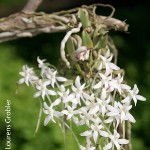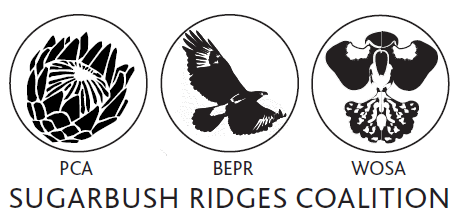Mystacidium venosum
Description
Miniature epiphyte with stems 10-15 mm long. Leaves strap-shaped to elliptic, unequally bilobed, up to 45 mm long and 10 mm wide, often poorly developed or absent. Inflorescences, one to several, up to 50mm long,4-10 flowers, white and 15 mm in diameter. Petals and sepals reflexed, spur tapering, up to 45 mm long. Similar to Mystacidium capense, distinguished by different flowering time and shorter leaves and spur. Pollinated by hawk moths. Fragrance sweet, scented at night.
Distribution in South Africa
Northern coastal part of the Eastern Cape, KwaZulu Natal, Mpumalanga and Limpopo.
Please submit your orchid photographs to OrchidMAP as citizen science records to improve this map.
Register on the Virtual Museum or login.
Typical habitat
Occasional in montane and coastal forests, from near sea level to 1700 m. Occurs on the main trunk of trees, as well as thinner branches. Conditions can be shady or exposed.
Flowering Period
This species typically flowers between April and July.
Distribution elsewhere in Africa
Also found in Mozambique.
Conservation Status
Widespread and known from many localities and a variety of habitats and is regarded as being safe.
Click on the distribution map to see the latest conservation status also refer to Provincial Species List on this site for Provincial Red and Orange listing and SANBI Orchid red list.
All indigenous orchids are protected under South African legislation as well as CITES regulations.
References and additional information
Johnson, S.D., Bytebier, B. Stärker, H. (2010). Orchids of South Africa: A field guide. Struik Nature, Cape Town, South Africa.
La Croix, I.F. la Croix, E. (1997). African Orchids in the Wild and in Cultivation. Timber Press, Portland, Oregon, USA.
McMurtry D, Grobler L, Grobler J, Burns S. (2008). Umdaus Press. Field Guide to the Orchids of Northern South Africa and Swaziland.
This genus and species article was written by Duncan McFarlane and published 2019-06-05.
Proof-read and published by Karsten Wodrich.
Images


